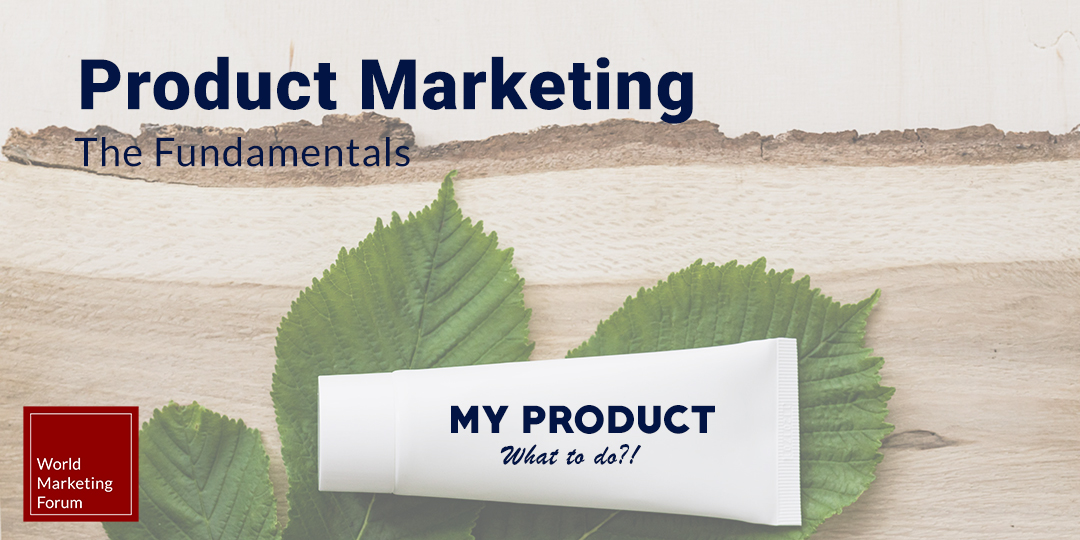The guiding force behind bringing goods to market – and keeping them there – is product marketing.
Product marketers are the overarching consumer personalities, masterminds of marketing, distribution enablers, and adoption accelerators. Much of this is happening at the same time. Product advertisers are some of the most professional plate spinners on the planet.
A product offering is a collection of platform features that work together to provide a unique value proposition to a customer. That product or service can be given a name, advertised, priced, sold, and supported.
As our firm grows, we are always out in the market, selling special deals to “whale” clients and then packaging the skills we develop into product offerings for our staff to sell and scale. With time, you and I will be able to sit back and admire the lovely portfolio of product offers we’ve created.
Photo by Karolina Grabowska from Pexels. Adapted and Transformed by the World Marketing Forum.
Defining a Product
We can define a product as anything – items, services, or ideas – that is sold in a market to meet the requirements and desires of customers.
The process of bringing a product to market is referred to as “product marketing.” This includes determining the product’s positioning and messaging, introducing it, and ensuring that salespeople and customers know it. The goal of product marketing is to increase the demand and consumption of a product. Merchandise is the term used in the retail industry to describe goods. Products are the formal concept of project deliverables that shape the project’s priorities in project management.
A product can also be anything that we can give to consumers in exchange for their attention, purchase, use, or use to fulfill a need or desire. However, a product is not limited to physical goods such as a vehicle, a refrigerator, or a phone. Since intangible objects may be sold to a consumer, the product concept must include them. As a result, programs, activities, people, sites, organizations, and even concepts/ideas fall under the general idea of the product. As a result, the product concept encompasses a wide variety of items: a car, a phone, and a cup of coffee are all examples of products.
Classification of Product
Also known as final goods, consumer products are items purchased for personal consumption by persons or households. In other words, commercial items are goods purchased by ordinary people for personal use. There are four categories of consumer goods in marketing, each with its own set of marketing factors.
Consumer Product
- Convenience products
- Shopping Products
- Sought Products
- Unsought Products
Convenience Products
Consumers are more likely to purchase convenience products. They are purchased without any thought or reference to other alternatives. Convenience goods are usually low-cost, undifferentiated from other products, and put in areas where customers can conveniently buy them. The goods are readily available, necessitate widespread marketing, and are located in convenient places.
Convenience products include bread, bus tickets, detergent, soft drinks, headphones, papers, etc.
Convenience Products Characteristics
- Frequently purchased
- Affordable prices
- Easily accessible
- Rarely compared with other products
Shopping Products
Consumers are less likely to purchase shopping items. Consumers typically equate shopping product characteristics such as content, price, and design to other things. As a result, users compare shopping options more carefully than comfort products, and they devote significantly more time comparing alternatives. Shopping goods require personal selling and advertisement, are available in smaller markets (than grocery products), and are sold more selectively.
Shopping items include, electronics such as blow dryers, tv, jackets, telephones, etc.
Shopping Product Characteristics
- Less frequently purchases.
- At a mid-range price.
- Frequently contrasted with other items.
Speciality Products
Speciality brands are those that have distinct features or distinct brand identity. Consumers who like to buy niche items are likely to go to great lengths to do so. Buyers should not spend much time comparing speciality goods to other products because they are usually expensive. Instead, consumers of niche goods put in more time than buyers of different kinds of products.
Take a Bugatti Car, for example (a speciality product). Buyers of a Bugatti will have to put in a lot of work to find one. Speciality goods necessitate targeted promotions and exclusive distribution; they are only available in a few locations.
Speciality items include sports cars, designer clothing, exotic perfumes, luxury watches, and well-known paintings.
Speciality Product Characteristics
- With distinct characteristics or a distinct brand image
- Less regular purchases.
- High price point
- Often compared to another product.
- Only accessible in a limited number of locations.
Unsought Products
Unwanted or unsought goods customers do not usually purchase or may not consider purchasing under normal circumstances. Unwanted commodity buyers seldom consider them unless they are in desperate need of them. The cost of products that aren’t in high demand varies.
Unwanted goods necessitate aggressive ads and personal selling because they are not commonly thought of by customers.
Unwanted products include diamond rings, pre-planned events, and life insurance.
Unsought Product Characteristics
- Consumers aren’t thinking about it.
- Extensive advertisement and distributing campaigns are needed.
- Understanding the Different Types of Consumer Products is Critical
It’s critical to know what items’ comfort is, shopping, niche, or unsought. As previously stated, each form necessitates special marketing efforts. It wouldn’t make sense to spend a lot of money on selling sugar, for example. There is no difference between different sugar products, so spending money on ads will shift consumer perception.
Unsought products, on the other hand, would necessitate significant marketing efforts. Buying life insurance is not top-of-mind; it is not something that most people consider. As a result, effective marketing and advertisement campaigns are needed to make unsought goods known and persuade customers to buy them.
Product Items, Lines, and Mixes
A product is something that is sold to meet the desires and needs of customers. The product consists of both tangible and intangible products that can be purchased on the market. At any given moment, a company sells a range of items. PepsiCo, for example, offers hundreds of things under the beverage, food, and nutritional product lines.
Product Line
A product line is a collection of goods produced by a corporation under a single name. The goods are comparable and target the same consumer segment. Maybe they have the same or related functions or channel delivery. Perhaps their physical characteristics, costs, pricing, or customer types are similar. The activity product lining is what we term it.
A business may have several product lines. Its capabilities, i.e., how efficient it is, are reflected in the number of product lines.
Product line figures can also indicate how competitive the business is against other players in the industry. It is also a set of closely related items with similar features, target audiences, distribution channels, and price points.
More Examples include:
- Toyota has several vehicle lines.
- Colgate Palmolive manufactures a variety of toiletries.
- Microsoft, Google, and Apple provide the operating system, the hardware on which it runs, and the applications and apps that allow the OS and hardware.
- Coca-Cola and Pepsi offer a variety of soft drinks and also water.
Benefits of Products Lines
Organizing similar products into product lines has many advantages for businesses:
- Advertising economies: Product lines allow for advertising economies of scale. Under the umbrella of the line, a variety of items may be promoted.
- Box uniformity can help a product line look more consistent. Even if all of the packages in the line have the same appearance, they retain their identities. A good example is Starbucks.
- Product lines allow companies to standardize parts, lowering manufacturing and inventory costs. An example includes: Laptops (mostly companies use the same components such as keyboard, screens on many laptop models)
- Efficient sales and distribution: A product line allows salespeople at companies like Procter & Gamble to offer customers a wide variety of options. If a company has a complete line of goods, distributors and retailers are more likely to stock it. A product line’s transportation and warehousing costs are likely to be lower than selecting individual goods.
Product Mix
The Product Mix, also known as Product Assortment, refers to the whole range of goods that the company sells. In other words, product mix refers to the number of product lines available to a company’s consumers.
Product mix refers to the combination of these product lines. For example, the Puma product line includes footwear, apparel, and sporting goods; when all of these product lines are combined, the product mix is created.
Product Line and Product Mix – What’s the difference?
A product line is a product category or brand that a company markets. A product line’s products all serve the same purpose, provide similar benefits, target similar consumers, are similarly priced, and are distributed through similar channels. Line stretching, line filling, line modernization, and line featuring are all-important product line attributes.
A company’s product mix refers to the total number of product lines and specific goods or services it offers. Brand portfolio or product assortment are other terms for the same thing. Product combinations differ from one corporation to the next.
Some companies have several product lines, each with a large number of products. Others, on the other hand, are severely restricted.
The total number of goods that a company offers to sell is referred to as the product mix. On the other hand, a product line refers to a group of related goods with everyday users and functions. Nike’s product lines include boots, clothing, and supplies, as seen above. The combination of these product lines is known as a product mix.
There are four dimensions to a product mix strategy:
- Width A company’s total number of product lines.
- The total number of items in a company’s product mix is measured in duration.
- Depth A product line’s total number of product variants.
- The term “consistency” refers to how product lines are related to one another.
Starbucks Product Line and Mix
| Coffee | Tea | Baked Goods | Frappuccino | Smoothies |
| Americanos | Jade – Citrus – Mint Tea | Madeleines | Strawberry Creme | Orange-Mango |
| Brewed Coffee | Iced Peach Green Tea | Vanilla Biscotti with Almonds | Mocha Cookie Crumble | Strawberry |
| Blond Roast | Iced Matcha Latte | Shortbread Cookies | Caffe Vanilla | Chocolate |
| Cappuccino | Iced Matcha Lemonade | Dark Chocolate Grahams | Java Chip | |
| Expresso | Raspberry Black Tea | Rip van Waffles | ||
| Latte | ||||
| Machiatto |
Width (Horizontal): Product Mix
Depth(Vertical): Product Lines
Product Modification
Product modification is the process of improving existing products by making essential modifications to their qualities, nature, size, packaging, and colour, among other things, to respond effectively to changes in market demand. Product modification aims to retain current orders, attract new users, and effectively compete with competitors. It aids in raising the company’s sales, which leads to an increase in the company’s profitability. The following renowned authors have defined the word “Product Modification.”
“A product modification is any deliberate altering of a product’s physical features or its packaging,” – Philip Kotler.
Product Modification Strategies
Many businesses do annual product reviews to ensure their offerings are appropriate for their target market or end customer. These businesses are known for being proactive and forward-thinking. In other situations, they are forced to reassess their products due to competitive pressure, changes in consumer demand, the availability of new materials, or technological advancements. Whatever motivates organizations to modify their existing product line, it is critical to be aware of any modifications that may impact sales and profitability.
Strategy for Improving Quality
The product quality can be increased with this method by altering the engineering process or changing the material from which it is made. The goal of this strategy is to face market competition successfully.
Strategy for Enhancing your Style
The appearance of the product is altered in this method. However, the product’s quality stays the same. The product’s packaging, as well as its size, shape, colour, and other characteristics, may be altered. The fashion business uses this method frequently.
Strategy for Enhancing Functional Aspects
Functional changes are any adjustments that improve the product’s functionality or meet new needs. The product’s design is altered to make the new design more appealing to customers, and they find it easier to use.
Strategy for Packaging Improvement
It’s a marketing tactic in which the product’s packaging is altered. These enhancements may be required due to the development of new packaging techniques, a flaw in the product’s current packaging, or user suggestions for revisions.
Repositioning
The practice of modifying the existing place a brand occupies in customers’ minds is referred to as repositioning.
Simply said, it is the process of influencing how the target market views the brand or its offering concerning its objectives:
- Competitors
- Features
With repositioning, the company aims to modify the way customers perceive the brand while maintaining the customer-business relationship. It entails updating or refreshing the brand’s promise and attitude with a new or revised concept
- Marketing mix
- Brand identity
- Target customer
- Brand essence
Examples:
- Colgate’s first products were soap, candles, and starch. It was eventually rebranded as a toothpaste brand.
- Before becoming the video gaming pioneer, we know today, Nintendo began as a playing card manufacturer in 1889.
- Google began as a simple search engine before repositioning itself as an internet king.
Product Line Extention
Consider how much you want that bag of chocolate chip cookies, let’s say Oreo Cookies; you pick up a package and examine the food label as you pass by the grocery store display. You notice the calorie count and realize you can’t buy them.
What if there was a lighter version of Oreo Cookies that had half the calories? Wouldn’t you put that package in your cart? Product line additions include making a light version, a mint taste, a snack edition, and a unique Halloween pink and black biscuit.
When a corporation introduces a new product in the same product line as an established brand, this is known as a product line extension. An extension strategy could be a new colour or size, and it could even contain different contents or tastes. To give customers more options, the company promotes the value and quality of its existing product line.
Because you already have a successful brand, product line extensions are relatively low risk. However, you don’t want to overexpose your brand until customers know what things you have to offer. As a result, it’s critical to maximize your exposure while remaining prudent. There are situations when a brand extension is a more effective marketing strategy.
Product Line Contraction
Products become outdated and unprofitable over time as a result of technological advancements and changes in client preferences. Product line contraction refers to the dropping of a product or the slimming down of a product line. When a product is discontinued, the company’s turnover suffers significantly. Before commencing on a product-line contraction strategy, the company should compare each item to the competition’s and evaluate its relative strengths and flaws.
If the best buy store decides to remove a particular brand of laptop from the laptops shop product line, it is an example of contraction.
Branding
The marketing method of consciously shaping your brand is known as branding. That is the most straightforward concept, but there is a lot more to it.
Your company’s branding is what it takes to cut through the noise and capture the interest of your target customer. It’s what converts indifferent consumers into brand evangelists and turns first-time buyers into lifetime customers. It’s what you’ll need to stand out, make an impression, and propel your company forward.
To put it another way, branding is non-negotiable if you want your company to thrive.
Whats’s the Importance of Branding?
The fine art of consciously shaping your brand is referred to as branding. A brand may develop an identity that distinguishes itself from the competition and establishes a link with its audience through imagination, expertise, and strategy. Louis Vuitton serves as an example of the value of branding.
Also, the most successful companies would be uninteresting if they lacked a firm name.
Branding is what gives you a name and, most importantly, a future. Because of the importance of branding, companies and organizations should start by developing a solid brand that they can sustain as they expand.
Benefits from Branding
Building and sustaining a good brand has many advantages. Here are a few of the most significant benefits of having a good brand:
- Recognize your customers. Customer recognition is aided by having a good name. This means that when a customer is looking for a specific product or considering a service provider, they can see your company listed among the options. Even if they don’t know anything about your business at the moment, customers are far more likely to prefer a familiar brand over something new.
- In the industry, you have a competitive advantage. Your brand is what sets you apart from the competition.
- Customers who know and support your brand give your business a competitive advantage. The more you gain respect for your brand, and the more you develop it, the more you’ll notice that it elevates and becomes competitive with other well-known brands.
- New product launch is easy. It is also quicker and less costly to launch new products or try them out before investing more in them when you already have a good reputation and loyal customers. Customers loyal to your brand will be interested in new products and will even wait for them to be launched if you have a strong brand following.
- Customer satisfaction and mutual beliefs are important factors. The appreciation and elevation enhance customer loyalty that a good brand provides. Customers are drawn to brands that share their beliefs. To create an emotional bond with consumers, you must communicate these principles while building a solid brand. Brand loyalty can last a lifetime, and it can even be passed down across generations.
- Increased trustworthiness and ease of purchase. Your reputation with consumers, your business, and the marketplace as a whole is enhanced by having a solid, well-known brand. You gain respect, loyalty, and competition as you increase your reputation.
What’s the concept of a Brand Strategy?
A brand strategy can be challenging to describe, but it includes:
- What the brand represents?
- What commitments does your business make to its customers?
- What kind of personality does your company’s marketing project?
- Many of these objects, as you can see, are intangible. How do you know if you’ve succeeded in expressing a specific personality?
- How do you know if you’ve effectively represented your brand or if you should be doing a better job?
Brand sentiment is the most critical indicator for a good brand strategy. And just because it’s challenging to quantify doesn’t mean you can disregard it. While it may be difficult to measure, it is all too common for empirical CEOs to overlook the qualitative work that goes into branding.
“Experience creation is handled by a different portion of the brain than experience scaling. It’s a whole range of abilities. The scaling experience is a challenge that requires a lot of analysis, operations, and technology. The end-to-end experience design is a more intuition-based human, empathetic understanding.” – Airbnb CEO Brian Chesky
It may seem insignificant, but two separate skill sets will be managed by two different teams who are unlikely to collaborate, let alone agree on anything in a larger organization.
That is how time, resources, and energy are squandered. You may be lacking a “creative” angle entirely in a small startup.
Trademarks – What is it?
A recognizable insignia, expression, word, or emblem that denotes a particular product and legally distinguishes it from all other products of its kind is referred to as a trademark. A trademark is a symbol that uniquely identifies a product as belonging to a particular company and acknowledges the company’s ownership of the name. Trademarks are a type of intellectual property that can be registered or unregistered.
Packaging
Packaging helps to keep the world in order. The things we put things in are vital, whether it’s a packet for your snicker’s chocolate, a hamper for your dirty laundry, or a container that keeps the delicious liquid particles of your beer together.
The development of a product’s exterior is referred to as product packaging design. This includes material and shapes options and graphics, colors, and fonts used on the packaging, a package, a can, a bottle, or any other type of container.
Packaging has the following primary purposes:
- Protection
- Recycling
- Specification
- Usefulness
- Publicity
Protection
One of the essential packaging functions is to protect natural and manufactured goods from the effects of time and the environment. The protection feature can be classified into several categories, including:
- Degradation by natural causes:
- It is caused by the contact of products with water, pollutants, fumes, microbiologic organisms such as bacteria, yeasts, moulds, heat, cold, etc.
- Physical Protection:
- The packaging also provides physical safety, including improved shock protection, internal product protection, and the reduction of shock damage caused by vibration, snagging friction, and impact.
- Strong and Protective Packaging:
- A specific type of protective packaging is needed for items considered hazardous to those who transport or use them. Highly flammable gas and liquids, radioactive elements, dangerous materials, and other things are among these products. Packaging should be designed in such a way that children cannot easily use or dispose of them.
Specification of Products
The packaging provides customers with essential details. The general features of the product, the ingredients, the net weight of the contents, the manufacturer’s name and address, and the maximum retail price are all examples of standard details provided by packaging (MRP).
Medicine and certain food items must provide information about preparing them, recipes and serving suggestions, nutritional benefits, and the date of manufacture, expiration date, warning messages, and cautionary statements. The colour of the packaging itself may often reveal detail. The orange colour of Mirinda or Fanta bottles, for example, indicates that these brands.
Usage
Foods, household chemicals, medications, adhesives, paints, cosmetics, paper goods, and various other items have benefited from convenience packaging. Dispensing machines, prepackaged hot metals, and disposable medical packaging are examples of this form of packaging.
Publicity
Companies advertise products with appealing colours, logos, icons, and captions that can affect consumer buying decisions.
Labelling
Brand recognition is made possible by labelling, which is a part of branding. It is a written piece of information affixed to the product for identification and offers accurate product information. When customers see the product labelling at the point of purchase, they make an easy decision.
Labelling is divided into two categories:
- Persuasive Labeling
- Informative Labeling
Clear labelling mainly focuses on promotional themes or logos.
Greenwashing
Greenwashing occurs when a company spends time and money claiming that its products or services are environmentally friendly when they are not. In other words, greenwashing is the practice of making false or misleading statements about a product’s, service’s, or technology’s environmental benefits.
UPC – Universal Product Code
UPC numbers are product-specific 12-digit numeric codes. Because these codes are universal, they will follow your product from store to store. Anyone can scan your UPC, and it will be recognized as your product.
UPCs are also exceptional, so each item in your collection would need its UPC—even variations of the same thing (like a T-shirt in five different colours).
The GS1 US, which is part of an international standards body that establishes product recognition and registration rules, regulates UPCs. Since the GS1 US is an international organization, the UPC can also be used as a global trade identity number (GTIN) or European article number (EAN), which is helpful if your business does much international business.
Global Issues in Branding and Packaging
A company has three options for handling the brand name while preparing to reach a global market with an established product:
- One Brand Strategy
- Adaptations and modifications
- Numerous brand names in multiple markets
One Brand Strategy
The phrases one-brand strategy and single-brand strategy are often interchanged or used interchangeably. They are, however, distinct:
Definition: When an organization only uses one brand, we refer to it as a one-brand strategy. This can be – but isn’t required to be – the company’s brand. Innocent Alps GmbH, for example, focuses solely on the Innocent brand and sells a range of items under that banner.
For a one-brand strategy to work, brand managers must understand their credit limits to avoid overextending the brand and risk losing its appeal.
As a result, a company may either restrict its brand architecture to one brand (one-brand strategy) or offer several products (multi-brand strategy). This is referred to as a multi-brand approach.
Single Brand Strategy Concept
When a corporation employs a single-brand strategy, its products are targeted solely at a specific market segment. Each brand has its own “personality,” which is run separately from its other brands and differentiated. These are known as mono brands or commodity brands in the world of branding.
In this tactic, the company’s name fades into the background. Hanuta, Nutella, and Mon Cherie, both of which are owned by Ferrero, are examples.
Brand Adaptation and Modification
The idea of Brand Adaptation refers to a company’s reuse and slight modification of a brand’s visual, typographic, or marketing components and its overall branding strategy. A foreign language is widely used in a developing country, a company’s brand name may be changed. Sometimes the brand name is kept hidden behind the scenes to avoid negative publicity for one of its goods. For example, Green Pak tea can face difficulties in the Indian Market.
The brand name may refer to an unflattering nature, a brand-damaging term, or everyday use in such situations. The brand must adapt and adjust its established branding strategy to appeal to the particular market.
Even companies on their way to building robust and versatile brands can find themselves in a situation where their brand no longer speaks to the relevant target market group or performs poorly in a new geographic area.
Businesses of old products or others who cannot communicate with a new consumer base often participate in Brand Adaptation to improve their appeal to new and current consumers.
Numerous Brand Names in Multiple Markets
An international marketer has many options for deciding on a brand name in multiple markets:
- Using a single brand that does not need to be adapted for different markets.
- Adapting and changing the name for each market.
- Using different names for the same goods in foreign markets.
- Using the business name as a brand name under one house style or the corporate umbrella approach (multiple brand names in different markets). This strategy is effective when a corporation mainly markets a single widely marketed product, and the brand name does not appear to clash with local culture in various societies.
- Benefits Provide greater international recognition of the product with the business; assists in achieving more excellent continuity and synchronization of advertisement and promotion on a global scale; allows for consistent brand identification with a company known for quality or technological superiority—assists in avoiding confusion with other companies’ goods.
- Changing the brand name in each market Some factors may force a company to change its brand name to fit local conditions. In the 1960s, Nestle, for example, launched many new products in Europe by changing the brand name for each country. In Germany, it’s known as “Nescafe Gold,” and in the United Kingdom, it’s known as “Nescafe Gold Blend.”
Product Warranty
A product warranty is a promise made by a company to a consumer about its quality and what compensation will be paid if it fails to work as advertised.
- Written guarantee = express warranty
- Unwritten guarantee = Implied warranty
Warranties usually include exclusions that restrict a manufacturer’s obligations. Examples of such exceptions include:
- The warranty’s date of expiration.
- The product is not being used in the way it was intended.
- After purchase, the product is resold.
A manufacturer can also provide language in a warranty that imposes additional restrictions. They may give an enhanced warranty for purchase that extends the warranty’s security beyond that included with the product.
Express Warranty
Express warranty is a promise made in writing or orally that guarantees a certain degree of functionality or quality for a set period. Such warranties do not tend to be conventional warranties but instead advertising promises, such as ensuring that a light bulb would last for a certain number of hours or years. Any express warranty must be labelled as either “absolute,” which means there is no time limit, or “limited,” which means there is a time limit. The Magnuson-Moss Warranty Act will cover an express warranty if it is written.
Implied Warranty
A standard warranty that comes with almost all consumer goods is an implicit warranty, which is the basic understanding that a product will work as advertised. An implied warranty, for example, means that a product sold as a mobile phone should work as a cell phone, and if it doesn’t, the seller violates the contract. To get around this, retailers can use the word “sold as-is” to cancel post-purchase commitments, but this is not permitted in all states.





